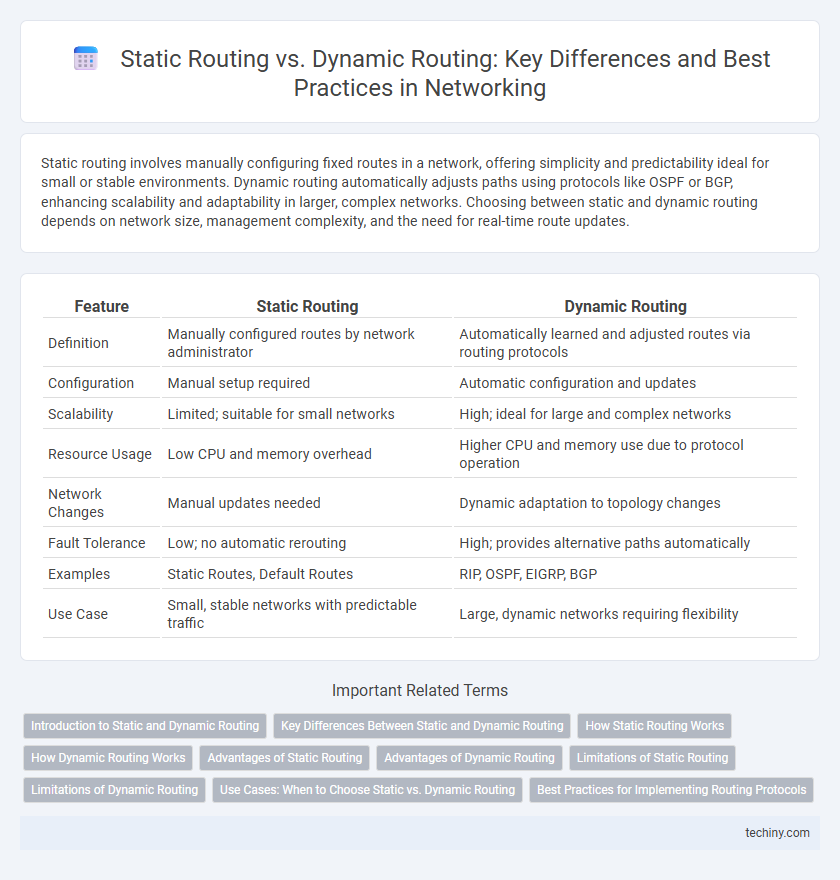Static routing involves manually configuring fixed routes in a network, offering simplicity and predictability ideal for small or stable environments. Dynamic routing automatically adjusts paths using protocols like OSPF or BGP, enhancing scalability and adaptability in larger, complex networks. Choosing between static and dynamic routing depends on network size, management complexity, and the need for real-time route updates.
Table of Comparison
| Feature | Static Routing | Dynamic Routing |
|---|---|---|
| Definition | Manually configured routes by network administrator | Automatically learned and adjusted routes via routing protocols |
| Configuration | Manual setup required | Automatic configuration and updates |
| Scalability | Limited; suitable for small networks | High; ideal for large and complex networks |
| Resource Usage | Low CPU and memory overhead | Higher CPU and memory use due to protocol operation |
| Network Changes | Manual updates needed | Dynamic adaptation to topology changes |
| Fault Tolerance | Low; no automatic rerouting | High; provides alternative paths automatically |
| Examples | Static Routes, Default Routes | RIP, OSPF, EIGRP, BGP |
| Use Case | Small, stable networks with predictable traffic | Large, dynamic networks requiring flexibility |
Introduction to Static and Dynamic Routing
Static routing involves manually configured routes by the network administrator, providing predictable and secure path selection for small or simple networks. Dynamic routing uses routing protocols such as OSPF, EIGRP, or BGP to automatically discover and adjust routes, enhancing scalability and fault tolerance in larger or changing network environments. Both methods determine the best path for data packets, but dynamic routing adapts to network topology changes while static routing requires manual updates.
Key Differences Between Static and Dynamic Routing
Static routing requires manual configuration of routes and is suitable for small, stable networks due to its simplicity and low overhead. Dynamic routing protocols like OSPF or EIGRP automatically adjust routes based on network changes, providing scalability and fault tolerance for larger, complex networks. Static routing offers predictable path selection, while dynamic routing adapts to topology changes for optimized traffic flow and redundancy.
How Static Routing Works
Static routing works by manually configuring fixed paths in a router's routing table, specifying exact routes for packet forwarding without automatic updates. These routes remain constant unless modified by the network administrator, ensuring predictable and low-overhead routing decisions. This method is ideal for small or stable networks where route changes are infrequent and network topology is simple.
How Dynamic Routing Works
Dynamic routing functions by using routing protocols such as OSPF, EIGRP, or BGP to automatically discover and maintain routes within a network. Routers exchange routing information through periodic updates or triggered events, allowing for real-time adaptation to network changes and failures. This process enables dynamic routing to optimize path selection and improve network resilience without manual intervention.
Advantages of Static Routing
Static routing offers enhanced security by limiting route updates to manual configuration, reducing the risk of unauthorized route changes. It provides predictable and stable network paths, which minimize routing loops and fluctuations common in dynamic routing protocols. Furthermore, static routing consumes minimal bandwidth and CPU resources since it does not require constant route advertisements or calculations.
Advantages of Dynamic Routing
Dynamic routing adapts automatically to network topology changes, ensuring optimal path selection and reducing manual configuration errors. It improves scalability by efficiently handling large and complex networks with automatic route updates. Dynamic routing protocols like OSPF and EIGRP enhance network resilience through fast convergence and load balancing capabilities.
Limitations of Static Routing
Static routing requires manual configuration and updates, making it impractical for large or frequently changing networks due to increased administrative overhead. It lacks automatic route discovery and adaptability to network topology changes, resulting in potential routing mismatches or downtime. Static routes do not support load balancing or redundancy, limiting network scalability and resilience compared to dynamic routing protocols.
Limitations of Dynamic Routing
Dynamic routing faces limitations such as increased complexity in configuration and troubleshooting compared to static routing. It can cause higher bandwidth consumption due to continuous route updates and is susceptible to routing loops and convergence delays during network topology changes. Scalability issues may arise in large networks where frequent updates overwhelm router processing capabilities.
Use Cases: When to Choose Static vs. Dynamic Routing
Static routing is ideal for small networks or simple, predictable environments where routes rarely change, such as in branch offices or point-to-point links. Dynamic routing suits larger, complex networks with frequent topology changes, like enterprise or service provider environments, as it automatically adapts to network conditions. Choosing static routing reduces overhead and improves security in stable setups, while dynamic routing enhances scalability and fault tolerance in dynamic infrastructures.
Best Practices for Implementing Routing Protocols
Implementing routing protocols effectively involves selecting static routing for small, stable networks requiring minimal administration, while dynamic routing suits large, complex networks with frequent topology changes. Best practices emphasize properly configuring routing metrics, enabling route summarization to reduce table size, and securing routing updates through authentication methods like MD5. Network administrators should continuously monitor route convergence times and avoid mixing incompatible protocols to ensure optimal network performance and reliability.
Static Routing vs Dynamic Routing Infographic

 techiny.com
techiny.com